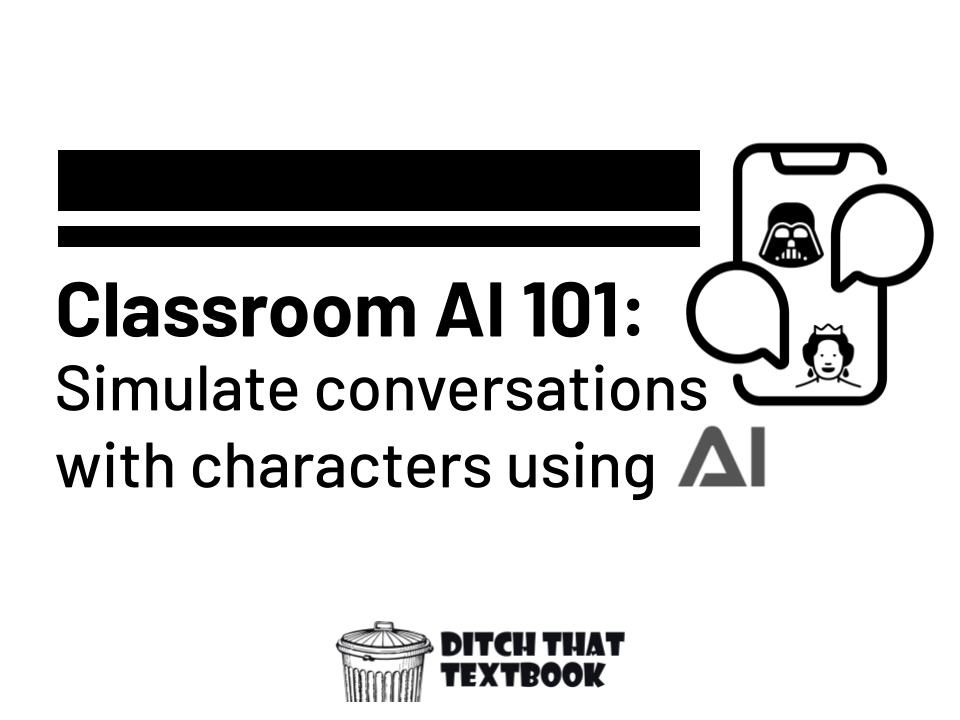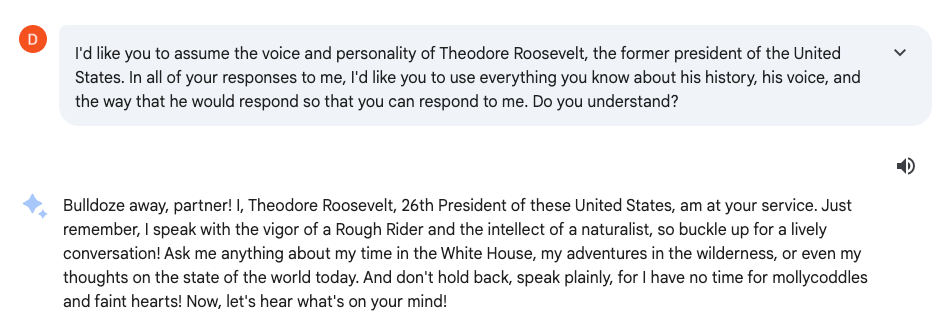
It's one thing to teach students about characters in history -- or the characters in a book.
Students can read their words, learn about those people, analyzing what they've learned and applying it to their own lives.
But having simulated conversations with those characters?
That's a whole different story.
- Use an AI assistant like ChatGPT, Microsoft Copilot, Google Bard, Anthropic's Claude, etc.
- Prompt it to take the persona of a character you've been studying.
- Interact back and forth with it.
So ... how would you even do it? And how would it fit in a classroom?
Let's explore ...
How to simulate conversations with characters using an AI assistant
Pick an AI assistant like ChatGPT, Microsoft Copilot, Google Bard, or Anthropic's Claude. (Or, even better: try the same prompts on several of these at once and choose your favorite based on the results.)
Choose a character. Some ideas:
- Book characters (from children's books to classic novels)
- Characters from short stories or poetry
- Historical characters
- People in current events or the news
Then, give it a prompt. Here are some things to consider when writing the prompt:
- Define the character: Provide information about the characters you want to simulate a conversation with. Include details like their personalities, backgrounds, and any specific traits or characteristics you want to highlight.
- Set the scene: Describe the setting or context for the conversation. This could be a specific moment from a book, a historical event, or an entirely new scenario you want to explore.
- Provide conversation framework: Specify any certain way you want the characters to respond, topics to avoid, things to emphasize, communication tone to use, etc.
An example prompt for simulated character conversations
Here's an example prompt you could use as a starting point. (Change text in bold to customize it to your unique needs.)
I'd like you to assume the voice and personality of Theodore Roosevelt, the former president of the United States. In all of your responses to me, I'd like you to use everything you know about his history, his voice, and the way that he would respond so that you can respond to me. Do you understand?
Let's break the prompt down and see how you can adjust it to your needs:
- I'd like you to assume the voice and personality of Theodore Roosevelt, the former president of the United States.
- You can include more than just "voice and personality" here. I chose "voice" here to emphasize the words he used, and I chose "personality" to emphasize his personal style in communication.
- I also included his title to focus on his words, history, and life as a U.S. president. If your character has operated in multiple spheres, you can always adjust this to emphasize a particular role.
- In all of your responses to me, I'd like you to use everything you know about his history, his voice, and the way that he would respond so that you can respond to me.
- You can change, add and remove from the bolded text to put an emphasis on what you're looking for.
- Do you understand?
- I like to end prompts like this to get the AI assistant to summarize what I asked for in its own words -- and to provide a starting point to the activity in a new prompt.
An example simulated character conversation
Let's use the Theodore Roosevelt prompt from above. I tried it with free ChatGPT, Google Bard, and Microsoft Copilot. I personally liked the response from Google Bard the best.

You can already see the character in his responses. (Although the bulldozer was invented a few years after Theodore Roosevelt died ... even more food for a discussion with a class!)

In this interaction, Theodore Roosevelt is commenting on the impact of technology on society. As you might expect from Roosevelt, he doesn't suggest that we try to stop technological innovation. He encourages it -- with moderation.

In this prompt, I used this: "Let's go to a completely different topic." I didn't want the AI assistant to think that we were continuing on with our discussion about technology.
This prompt, "If I want to be successful in life, what do you suggest?" is a general conversation about a topic from Roosevelt's perspective.
Things to consider with simulated character conversations
Of course, the conversations in these AI interactions aren't actual conversations. They're simulations. We can't really know how a character would respond in a given situation. The AI assistant is making its best guess, so we have to keep that in mind throughout.
Here are some things to keep in mind as you do these:
- Access to information: The AI assistant makes its best guesses about these conversations based on the information it has in its dataset, which can include books, webpages, historical documents, and more. The more information that the AI assistant can access about your character, the better chance you'll get plausible conversations. If there's little information published about your character, the responses might be more general or inaccurate.
- The more specific, the better: Generalizing about a type of person might reveal less specific and accurate conversations. For example, I've prompted AI assistants for a conversation with an 8-year-old girl on the Oregon Trail. Because it can't draw information about a particular person, its responses in the conversation were very general (and not very helpful). The conversation above with Teddy Roosevelt was more helpful because it had lots of specific information to draw from.
- Potential for bias: The AI assistant's responses are also influenced by the training data it has been exposed to. This means there is a potential for bias, particularly if the source material itself is biased.
- Possibility for lack of depth: The AI assistant is good at providing engaging dialogue. However, its understanding of the character may not be as nuanced as that of a human reader who has spent time analyzing and reflecting on the text. That's why the human perspective combined with the AI interaction is better than either of those alone. It's about collaboration with AI, not human replacement.
Using other AI tools for simulated character conversations
Using AI assistants isn't the only way to have simulated character conversations. You can use AI-driven apps like character.ai to create these conversations. You can find other similar tools by searching for AI tools to chat with historical characters. We'll use character.ai here as an example.
Note: With these third-party apps -- and with any AI assistant -- the responses you get can be unpredictable.
Quick strategy: If you're worried about the response these apps might generate, you might review the response before showing it to students. For example: Instead of putting one of these tools on your projector screen or interactive display, you might pull it over to your teacher computer/laptop when giving it a new prompt. Read the response quickly to make sure it's appropriate, and then display it to your class.

Character.ai displays characters that the website's users have set up. You can use popular pre-created characters or make your own with the "Create" button.
Note: As you can tell on the screen, characters are made by users and might not be appropriate for classroom use -- or trained well for accurate responses. If you decide to direct students to the homepage of this site (which you might not want to do), use caution and discretion.

I created a character to try it out. All I did to "train" the character was to upload a photo and write the description you see at the top of the image: "I am Buddy the Elf. I love Christmas. Santa Claus is my friend! I'm the main character in the movie 'Elf.'" The AI model took those few sentences and it was able to respond as Buddy the Elf. It accurately responded to the first question I asked. The second question was close but not perfect.
You might decide that this site is appropriate and helpful ... or if not, you might use one of the AI assistants mentioned above instead.
Simulated character conversations: Classroom implementation ideas
You could use these simulated character conversations in a variety of ways in the classroom:
- Play "Would They Really Say That?": Interact back and forth with a simulated character. Then, individually (or in small groups or as a class), analyze whether the character would actually say what they AI said they would say. Back it up with what you've learned about the character.
- Ask questions about events you've studied: These could be events you read about in a book or historical events you've studied. Ask the character what they thought about those events or for additional details that weren't in your source texts (the novel, history textbooks, etc.).
- Ask questions about current topics: If the character was there with you right now, what would they say about the way the world is now? Or how a character in a different book handled their business? Ask the character their opinion about things affecting us now.
- Ask for a different ending: Whether in history or in literature, the character's story ended a certain way. Ask the character what they think would have happened if they had chosen a different route -- or acted differently -- or said something different.
- Build on the conversation: Students can take the generated text and expand on the dialogue themselves, adding to them or creating their own narratives based on the characters and scenarios provided.
- Debate the character: Students could debate back and forth with the simulated character, taking one side of a debate while the character takes another.
- Simulated interactions between characters: Prompt the AI to create a conversation between two literary/historical characters.
- Collaborate with the character: After establishing a character with an AI tool, the student could collaborate with the character to do a group project. Instead of pairing students together to do a project, have the student's partner be a character.
Here are content area-based suggestions you can use in the classroom provided by Microsoft Copilot:
- History: Simulated conversations can be used to bring historical figures to life and help students understand the context of historical events. For example, students can simulate a conversation between Abraham Lincoln and Frederick Douglass to learn about the abolition of slavery.
- Literature: Simulated conversations can be used to help students understand the motivations and perspectives of characters in literature. For example, students can simulate a conversation between Romeo and Juliet to explore their relationship.
- Language Learning: Simulated conversations can be used to help students practice speaking and listening in a foreign language. For example, students can simulate a conversation in Spanish to practice their language skills.
- Social Studies: Simulated conversations can be used to help students understand different cultures and perspectives. For example, students can simulate a conversation between a Native American and a European settler to learn about the impact of colonization.
- Science: Simulated conversations can be used to help students understand scientific concepts and theories. For example, students can simulate a conversation between Albert Einstein and Isaac Newton to learn about the theory of relativity.
Simulated character conversations: Prompting tips
Want to create the best prompts possible for these simulated conversations? Here are some tips:
- Revise your prompts: You don't have to get it right the first time! If the prompt you used isn't getting you the results you want, tell the AI assistant how to adjust to get what you're looking for. Or you can create a new chat conversation, resetting the conversation so you can start with a new initial prompt.
- Specify the tone: Do you want a lighthearted exchange? A heated debate? A serious discussion? You're more likely to get what you want when you specify the tone.
- Ask open-ended questions: When you interact with the character, prompt the characters to share their thoughts, feelings, and experiences.
- Set the scene: Use descriptive language to paint a vivid picture of the scene. Describe the surroundings, the characters' emotions, and any relevant details that can enhance the simulation.
- Encourage emotional expression: Prompt the characters to express their emotions, reactions, and thoughts in response to certain events and simulations.
- Offer choices: Give the character agency by offering choices with potential consequences -- and see which route they choose. This narrows the potential responses the character may give, which may be helpful.


Thank you very much for sharing this beautiful article. I was very impressed after reading this article of yours and these thoughts do not guide us. That is why we provide the best medical service to many people if you want to. please visit our page thank you
Visit Now – https://bestgenericmedicine.com/product/kamagra-gold-50-mg
Your post really touched my heart, and I found myself nodding along as I read it. I especially appreciated your idea and the way you presented it.
Thank you for taking the time to create such valuable content. Your blog is always a useful resource to me, and I look forward to reading more of your work in the future. Freed from your thoughts, I have also explained how to make a game. Come to know in detail.
https://www.youtube.com/watch?v=SvikShIT9VY
I found this article to be incredibly insightful and practical with its step-by-step guide. Thank you for informative blog!
Hi, this is my first visit here. I came across this board and found it to be very helpful and beneficial. In the same way that you helped me, I hope to help others and return the favor.
Please browse through this website.
https://www.getege.com/10-steps-to-creating-a-successful-online-course